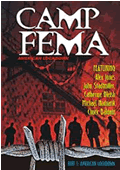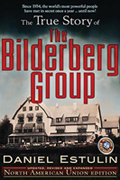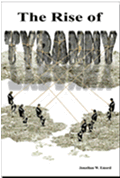THE
FOUR CARDINAL ERRORS THAT ALMOST DESTROYED AMERICA
PART 4
By Professor
Steven Yates
November 1, 2009
NewsWithViews.com
[Author’s note: a week or so after publishing “The Real Matrix” on this site four and a half years ago I received an email from a Terry Hayfield, an independent researcher based in Ohio, who offered to share his findings. While his core claim was different from what I’d proposed, there was a key point of congruence: both of us realized, in different ways, that there is indeed a “real matrix” in which most Americans are imprisoned, as it were: not by some AI device, of course, but by their so-called educations, mass media diversions, and the controlled political and economic systems—designed, respectively, to indoctrinate, distract, and create an illusion of choice within systems that are controlled from the top by a well entrenched superelite (as I called it)—working through such entities as the Council on Foreign Relations, the Trilateral Commission, the Bilderberg Group, and finally, the British Fabian Society. What had prompted Hayfield to write? I already realized that I had committed an error: because of the length of my discussion I had deleted a section on the Fabians. According to Hayfield, my error was worse: my conception of the “real matrix” was false, as it rested on a false premise: it neglected the Permanent Revolution.
Here, no doubt summarized too quickly, are Hayfield’s main claims based on four decades of research and study including direct experience working with organized labor. Outside the “real matrix” is the Permanent Revolution, a term referring not to any specific power elite but to a process, economic in nature, directing the actions of the elites, who do what they do not simply because they want to but because they have to. At the core of this process is a specific British-American capitalism, managed by the British Fabian Society for the Crown.
British-American capitalism has a design flaw: overproduction and underconsumption. Hayfield calls this the flaw of capitalism. Because of the flaw of capitalism, British-American capitalism is in constant turmoil; it must always change, expand, revolutionize itself from within—finding new markets for what it produces and finding ways of getting currency into consumers’ hands so they can buy what capitalists produce. Otherwise the system falls into crisis and must resort to some form of fascism. Harvard economist Joseph Schumpeter coined the phrase creative destruction to describe this continuous process of disruption and change (see his Capitalism, Socialism and Democracy, 1942). The superelite’s cure for the flaw of British-American capitalism is the Permanent Revolution—building up a global capitalism that at its height will evolve into global socialism and then into global communism (in the sense Marx originally intended for that term).
This process, according to Hayfield, is what is sweeping away—destroying—our Republic from within. It is crucial to grasp that in this view capitalism, socialism and communism are not alternative systems but components of a single process. British-American capitalism must exist in order for the socialism originally desired by the Fabians to exist. Conversely, socialism cannot exist without capitalism. British-American capitalism thus stands at the foundation of the process. Hence (1)
British-American capitalism—not socialism—is the enemy and must be the target of those who would save our Republic. Moreover (2): communism as usually defined is a myth. The Soviet Union was a poorly planned form of state capitalism. The Leninists attempted socialism without a capitalist base. Real communism thus hasn’t happened yet! British-American capitalism is creating the conditions for its creation!
Such a view is bound to raise eyebrows. More than one respondent has called Hayfield a closet Marxist. This is simplistic. He believes that nearly all Patriot organizations and publications are parts of the Hegelian ploy to create a “controlled opposition” and herd as many opponents into it as possible so that they may be safely neutered. He believes this happened with the John Birch Society, which had subterranean connections to Rockefeller dollars from the very start. Hayfield has adapted the term Perestroika for all these efforts, which he also believes includes Ron Paul’s rise to visibility.
I have commented critically on Hayfield’s research here and here; Hayfield responded here. I have reservations about a number of his conclusions, which include the idea of a new political fusion of “left” and “right” forming a new political party devoted to exposing the Fabians and thwarting the Permanent Revolution. He has more confidence than I do that independent voters will respond to an exposure of the Fabians. As of yet they have not responded to exposures of the much better known CFR and the Trilateral Commission, probably because they are more interested in sports and American Idol. I am unsure, more generally, that our Republic can be saved. In my pieces linked to above I expressed doubts about the existence of an economic process that stands above the aggregate actions of individuals, including the superelite. Using the principle known as Ockham’s Razor, we might consider that the superelite with its tremendous resources and pull, an educational system designed to turn us all into collectivists and subordinates, and the myriad distractions including the explosion in sexual innuendo in the marketplace since the Kinseyite revolution, just might suffice. But I do not dismiss out of hand the possibility of supervening historical laws governing these things. I know of cases of Republics becoming Empires (e.g., Rome); I know of no cases of Empires returning to being Republics. Doubtless there are reasons why this is the case.
Also, I am unclear what kind of society Hayfield would have us work toward, although he clearly sees the system instituted by the Articles of Confederation as superior to what came about later with the Constitution and when the Crown reasserted control (Jay Treaty). That doesn’t help us much today, of course, if for no other reason than the vastly greater complexity of society now. As bad as the present structures of domination are, the power vacuum created by their sudden end in a population accustomed to them seems to me equally if not more dangerous, which is why I continue to support specific piecemeal efforts such as Ron Paul’s, first to audit and then to eliminate the Federal Reserve—one thing at a time. Be all this as it may, I would like to see Hayfield’s research studied and discussed. After all, with the current manufactured crisis deepening, we need everybody’s ideas on the table, and not let our egos get in the way of frank and open dialogue. I am told that Mr. Hayfield has had hostile exchanges with other NewsWithViews.com contributors. This is unfortunate, because while my views are not congruent with his, his documentation is quite extensive and his specific claims about, e.g., the Fabians, check out. If it pushes the limits of our comfort zones, then so be it. Our purpose here is to learn and communicate the truth—or as much of it as we can uncover—not maintain feelings of intellectual security. For only on this basis can we expect our actions to succeed. And let’s observe that with last year’s very public bailouts of institutions deemed “too big to fail” and articles now appearing about Halliburton-subsidized detention camps not on “conspiracy sites on the Internet” but in the very mainstream San Francisco Chronicle, we are rapidly running out of time!]
Cardinal Error Four. Americans did not recognize the British Fabian Society for what it was, and remained blind as the Fabians infiltrated and slowly assumed control over every dominant institution in this country—paving the way for today’s unbridled globalism.
I.
Surprisingly few writers exposing this or that element of the world-government movement have mentioned the Fabians. Carroll Quigley’s Tragedy & Hope: A History of the World In Our Time (1966) appears to dismiss them out of hand without even naming them by name. He refers to “wild-eyed and bushy-haired theoreticians of Socialist Harvard and the London School of Economics” (p. 949). He left the impression that the Fabians are insignificant. This is wrong and must be corrected. Major economist and economic historian Joseph Schumpeter paid them homage (see his Capitalism, Socialism & Democracy, 1942) ; and it is significant that arch-capitalist Alan Greenspan also incorporates them into his discussion at strategic points (The Age of Turbulence, 2007). Rose L. Martin saw them as instrumental in having moved America leftward from the last turn of the century up to the 1960s (Fabian Freeway: The High Road to Socialism in the U.S.A., 1968).
Classical Marxism viewed the bourgeoisie and the proletariat as on a collision course that would end in violent revolution that would end capitalism and instill socialism. Once socialism had eradicated the last vestiges of capitalist domination it would evolve into communism. By the 1880s—at the end of Marx’s life—it was dawning on observers including Marx himself that violence was no more necessary than it was desirable. They could work toward the kind of society they wanted through penetration and permeation. Penetration involved infiltrating existing institutions by members of the Fabian Society. Permeation would involve furthering Fabian goals by non-Fabians once these institutions were hijacked. But who were the Fabians?
The mid-1800s was witness to an upsurge of interest in socialism, including in the English-speaking world. Robert Owen’s ideas and communal experiments had attracted attention. In the early 1880s, an organization called the Fellowship of the New Life began to meet. In January 1884, a splinter group was officially organized as the Fabian Society. Their credo stated explicitly, “The Fabian Society consists of socialists.” They took their name from Quintus Fabius Maximus, the Roman general who specialized in delaying tactics. Fabian Tract No. 1, a four-page leaflet, stated, “For the right moment you must wait, as Fabius did most patiently when warring against Hannibal, though many censured his delays; but when the time comes you must strike hard, as Fabius did, or your waiting will be in vain, and fruitless.” The Fabians’ symbol was the tortoise—moving ever forward; inoffensively; quietly, quietly; but always on the move. Arguably the Fabians never “struck hard.” But as it turned out, they didn’t have to.
The Fabians’ sources ranged from Owen to Darwinian evolution, and Comtean positivism. Of the latter, Edward Pease wrote in his History of the Fabian Society (1918), “his philosophy accepted science, future as well as past.” The Fabians, although far more interested in behind-the-scenes activism than in philosophy or ideology, fit nicely into the shift from a Christian worldview to materialism and Enlightenment humanism. They also drew on John Stuart Mill and Henry George, in addition to Karl Marx who had just died in 1883.
The most famous early members were, of course, Sydney and Beatrice Webb, and George Bernard Shaw the playwright. Other members included classical scholar Graham Wallas, psychologist and sexual-liberationist Havelock Ellis, theosophist Annie Besant, artist Walter Crane, historian Edward Pease, author Israel Zangwill, and Karl Marx’s daughter Eleanor. The Fabians continued meeting and strategizing—and expanding. They were excellent networkers. Their influence grew during the late 1880s and early 1890s, especially after the publication of Fabian Essays in 1890. This collection promoted socialism in language anyone could read—as opposed to Marx’s turgid prose most of which analyzed capitalism and elicited its supposed flaws instead of espousing socialism. In 1895 the Webbs accepted a large grant courtesy of the estate of Henry Hunt Hutchison to found the London School of Economics (LSE). The Fabians now had a visible center of influence! Their turtle moved steadily forward, and never looked back!
Close inspection of not-usually-cited but nevertheless crucial documents makes it clear that the Fabians hijacked Rhodes’s oft-cited plan for a secret society that would expand British control around the world, including America. Rhodes was no socialist, after all; but he had ideas the Fabians found useful, such as British-led globalism. According to William H. McIlhany’s The Tax-Exempt Foundations (1980), it was William T. Stead, a Fabian, who, in 1891, introduced Rhodes and future Round Tablers Alfred Milner, Arthur Balfour, and others. In other words, behind the “Anglophile network” of Round Table Groups Carroll Quigley credits in Tragedy & Hope (p. 950) were the Fabians! In 1900, the Fabian Society would be instrumental in helping organize the British Labour Party, with Shaw writing its constitution. By this time the Fabian Society claimed 861 members.
II.
There can be no doubt that the Fabians had landed on American shores. They knew Americans would not warm to socialism under that name. So they called themselves progressives. (Later, they would expropriate the word liberal.) American Fabians began to form study groups in American universities. Among the institutions they penetrated and permeated was Princeton, whose president Dr. Woodrow Wilson they would surround. In “Colonel” Edward Mandell House (ambitious son of Texas-based landowner and Rothschild agent Thomas House), they found a permanent link to the international banking cartel seated in the City of London and connected to the Crown.
House anonymously authored Philip Dru: Administrator (1912) which promoted a central bank, a graduated income tax, control over both political parties, and “socialism as dreamt of by Karl Marx.” He became Wilson’s right-hand man as the elites of the day promoted his presidency on the promise of his signing into law an act of Congress creating a central bank: what became the Federal Reserve Act of 1913. The infamous secret Jekyll Island meeting had already been held following the manufactured Panic of 1907, and the Rothschild-Rockefeller-Schiff-Morgan axis was ready to move.
The year 1913, of course, was pivotal in the ruination of our Republic. We saw the end of Constitutional money as control over monetary policy was placed in the hands of a private entity (strictly speaking, the first public-private partnership) controlled by a secretive cartel of private corporations. We also saw the first incarnation of the Internal Revenue Service, and the creation of the Anti-Defamation League. The former created the first direct, unapportioned tax. Such a tax had been ruled unconstitutional by the Supreme Court (Pollock v. Farmers Loan & Trust Co., 1895). The response was the change the Constitution by adding the Sixteenth Amendment. Today, shadows hang over that Amendment. Was it really ratified in the way the Constitution requires? Independent researcher William J. Benson says it wasn’t (see his The Law That Never Was, 1985). The courts have rejected Benson’s arguments as “frivolous.” Of course. The Anti-Defamation League, meanwhile, would later brand criticism of the Federal Reserve and other manifestations of superelite influence as “anti-Semitic.” Their attacks would all but destroy the reputation of Eustace Mullins, an independent scholar whose Secrets of the Federal Reserve (1952) was the first effort to expose the superelites behind its creation.
“Colonel” House, a master organizer with a huge network, assembled what he called the Inquiry. This is interesting, in light of what we learned about “commissions of inquiry” when investigating the Jay Treaty; the Fabians were still operating from Great Britain, after all. By this time, the Crown was surely looking on with quiet approval. Following a meeting at the Hotel Majestic on May 30, 1919, House’s Inquiry became the parent of both the Royal Institute of International Affairs in Great Britain and the Council on Foreign Relations in the U.S. The latter was formally organized in 1921. These organizations immediately began laying the foundations for a global society—which meant working against U.S. interests as a sovereign Republic based on the Constitution. They had suffered a setback in 1919 when the U.S. Senate torpedoed U.S. participation in the League of Nations, dooming one of their first brainchildren to irrelevance even though it survived in Europe for a time. The U.S. would, of course, join its stepchild the United Nations, in 1945.
The Fabian Society, meanwhile, continued to penetrate and permeate. Other highly influential Fabians included John Dewey whom we encountered in Part 3, author H.G. Wells, historian and author Arnold Toynbee, economist John Maynard Keynes, and major philosopher Bertrand Russell. Dewey, in addition to his Rockefeller-bankrolled Progressive Education movement, had a key voice in the Fabian-directed League for Industrial Democracy. Originally called the Intercollegiate Socialist Society founded in 1905, it changed its name in 1921 and soon permeated organized labor in America. Dewey was also closely tied to the American Humanist Association, becoming the lead author of its infamous Humanist Manifesto which attempted to work out a secular ethic to accompany the Comtean “scientific society.”
H.G. Wells would author not just early science fiction novels such as The Time Machine (1895) and War of the Worlds (1898) but also, following his time with the Fabians, The Open Conspiracy (1928) and The New World Order (1940). He had broken with them and was pursing an even more radical vision of a socialist World State incorporating Comte’s notion of a “religion of humanity.” The New World Order spoke chillingly of the opposition: “Countless people ... will hate the new world order, be rendered unhappy by frustration of their passions and ambitions through its advent and will die protesting against it. When we attempt to estimate its promise we have to bear in mind the distress of a generation or so of malcontents, many of them quite gallant and graceful-looking people.” In The Shape of Things To Come (1938), Wells presents a future in which his World State has eradicated Christianity.
Arnold Toynbee, an original Rhodes Round Tabler who later became official historian for the Royal Institute of International Affairs, would give an address in 1931 to his fellow globalists at the Conference of Institutions for the Scientific Study of International Affairs in Copenhagen entitled “The Trend of International Affairs Since the War” He would defend the need for secrecy in the assault on national sovereignty: “I will merely repeat that we are at present working, discreetly but with all our might, to wrest this mysterious political force called sovereignty out of the clutches of the local national states of our world. And all the time we are denying with our lips what we are doing with our hands…” (All italics mine.)
John Maynard Keynes had already realized (along with Lenin) that the way to destroy the free enterprise system was to debase its medium of exchange and make it fruitless for common people to save. In his book The Economic Consequences of Peace (1920) he stated, “Lenin is said to have declared that the best way to destroy the Capitalist System was to debauch the currency. By a continuing process of inflation, government can confiscate, secretly and unobserved, an important part of the wealth of their citizens. By this method they not only confiscate, but they confiscate arbitrarily; and while the process impoverishes many, it actually enriches some…. Lenin was certainly right. There is no subtler, no surer method of overturning the existing basis of society than to debauch the currency. The process engages all the hidden forces of economic law on the side of destruction, and does it in a manner which not one man in a million is able to diagnose.”
This is the same Keynes who would work out the details of what has become the dominant economic philosophy of today’s elite-controlled British-American capitalism, a system based on inflation, mass consumption, debt, and government’s “priming the pump” when the system fell into crisis as it inevitably would—repeatedly. Keynes’s General Theory (1936) became the economic bible of the Roosevelt / WWII era and for decades after. Keynes is still the most influential economist in the Western world. Everyone who believes that the federal government can spend a society into prosperity, or that printing-press money can generate more than pseudo prosperity (as it did during the 1990s) is under the long-term spell of Keynes. Clearly, and despite his initial defense of the gold standard under Ayn Rand’s temporary and superficial influence, this included Alan Greenspan. It presently includes Ben Bernanke as well as people like Henry Paulson (U.S. Treasury Secretary under George W. Bush) and Timothy Geithner (U.S. Treasury Secretary under Barack Obama).
Bertrand Russell, finally, developed openly some of the consequences of the Comtean “scientific society” in his books The Scientific Outlook (1931) and The Impact of Science on Society (1952). The focus is on education, and picks up where Rockefeller’s General Education Board left off. Russell proposed that in the “scientific society” the elite receive one kind of education while the masses receive another: “the scientific rulers will provide one kind of education for ordinary men and women, and another for those who are to become holders of scientific power. Ordinary men and women will be expected to be docile, industrious, punctual, thoughtless and contented. Of these qualities contentment will be considered the most important. In order to produce it, all the researches into psycho-analysis, behaviorism, and biochemistry will be brought into play.” And: “Education should aim at destroying free will so that after pupils are thus schooled they will be incapable throughout the rest of their lives of thinking or acting otherwise than as their school masters would have wished…. The populace will not be allowed to know how its convictions were generated. When the technique has been perfected, every government that has been in charge of education for more than one generation will be able to control its subjects securely without the need of armies or policemen.”
The upshot is that in the Comtean-Russellian “scientific society”—its masses educated according to methods proposed by Dewey in accordance with those desires expressed originally by Rockefeller’s General Education Board—science and technology would become not instruments of liberation but instruments of control.
|
Subscribe to the NewsWithViews Daily News Alerts! |
All this further explains why subjects like history and philosophy have been neutered, relegated to the status of academic decoration. The emerging superelite would not be philosopher-kings, as Plato had envisioned in The Republic, but technocrats of behavior. There would be a place for everybody, and everybody would be conditioned to stay in his/her place. Harvard’s B.F. Skinner, yet another recipient of Rockefeller dollars, would openly pursue the idea of a “technology of behavior” based on such notions as operant conditioning. The most visible result was his widely-read Beyond Freedom and Dignity (1971) which urged the rejection of “autonomous man,” i.e., men and women regarded as free to choose their own destiny in life, as opposed to that chosen for them by a technocratic superelite.
Click here for part -----> 1, 2, 3, 4,
� 2009 Steven Yates - All Rights Reserved

















